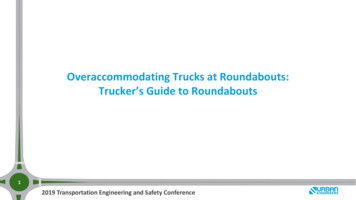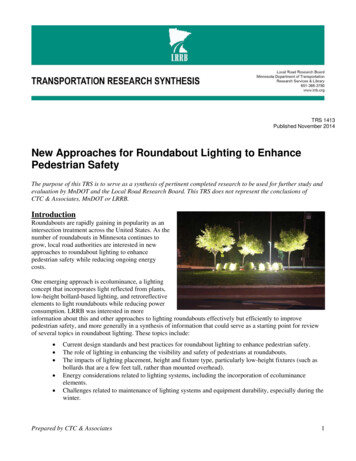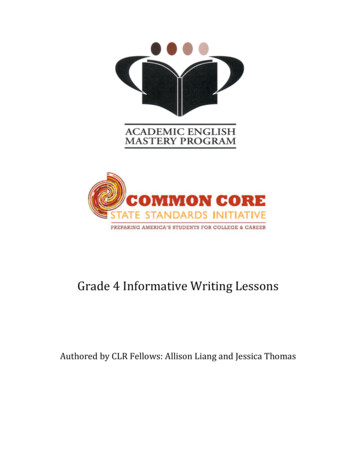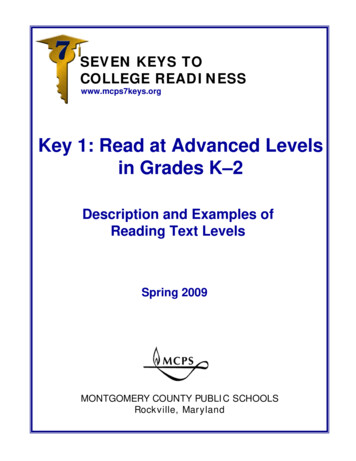
Transcription
CONTENTS
CONTENTS
CONTENTSRoundaboutsKittelson & Associates, Inc.Queensland University of TechnologyAn InformationalGuideRuhr-University BochumUniversity of FloridaUniversity of IdahoPennsylvania State UniversityHurst-Rosche EngineersEppell Olsen & PartnersBuckhurst Fish & JacquemartFHWA Project Manager:Joe tfhrc.govU.S. Departmentof TransportationFederal HighwayAdministrationPublication No.FHWA-RD-00-067
CONTENTSForewordRoundabouts are a form of intersection control in common use throughout the world. Until recently, manytransportation professionals and agencies in the United States have been hesitant to recommend andinstall roundabouts, however, due to a lack of objective nationwide guidelines on planning, performance,and design of roundabouts. Prior to the development of this guide, transportation professionals who wereinterested in roundabouts had to rely on foreign roundabout design guides, consultants with roundaboutexperience, or in some States, statewide roundabout design guides. To facilitate safe, optimal operationand designs that are both consistent at a national level and consequential for driver expectation andsafety, the Federal Highway Administration (FHWA) developed this informational guide on roundabouts.The information supplied in this document, Roundabouts: An Informational Guide, is based on establishedinternational and U.S. practices and is supplemented by recent research. The guide is comprehensive inrecognition of the diverse needs of transportation professionals and the public for introductory materialthrough design detail, as well as the wide range of potential applications of roundabout intersections.Roundabout operation and safety performance are particularly sensitive to geometric design elements.Uncertainty regarding evaluation procedures can result in over-design and less safety. The “design problem” is essentially one of determining a design that will accommodate the traffic demand while minimizingsome combination of delay, crashes, and cost to all users, including motor vehicles, pedestrians, andbicyclists. Evaluation procedures are suggested, or information is provided, to quantify and cost how wella design achieves each of these aims.Since there is no absolutely optimum design, this guide is not intended as an inflexible “rule book,” butrather attempts to explain some principles of good design and indicate potential tradeoffs. In this respect,the “design space” consists of performance evaluation models and design principles such as those provided in this guide, combined with the expert heuristic knowledge of a designer. Adherence to theseprinciples still does not ensure good design, which remains the responsibility of the designer.Michael F. TrentacosteDirector, Office of Safety Research and DevelopmentNOTICEThis publication is disseminated under the sponsorship of the Department of Transportation in the interestof information exchange. The publication does not constitute a standard, specification, or regulation. Anytrade or manufacturers’ names that appear herein are included solely because they are considered essential to the object of the publication.
CONTENTSTable of ContentsList of ExhibitsviiiPhoto CreditsxivChapter 1 - Introduction11.1Scope of Guide21.2Organization of Guide31.3Defining Physical Features51.4Key Dimensions51.5Distinguishing Roundabouts from Other Circular Intersections81.6Roundabout Categories121.7References20Chapter 2 - Policy Considerations212.1Characteristics232.2Multimodal Considerations322.3Costs Associated with Roundabouts362.4Legal Considerations372.5Public Involvement402.6Education432.7References48Chapter 3 - Planning493.1Planning Steps513.2Considerations of Context533.3Number of Entry Lanes553.4Selection Categories583.5Comparing Operational Performance of AlternativeIntersection Types64Space Requirements693.6Roundabouts: An Informational GuideV
CONTENTS3.7Economic Evaluation703.8References76Chapter 4 - Operation4.1Traffic Operation at Roundabouts824.2Data Requirements834.3Capacity864.4Performance Analysis914.5Computer Software for Roundabouts964.6References98Chapter 5 - Safety1015.1Introduction1035.2Conflicts1045.3Crash Statistics1115.4Crash Prediction Models1225.5References125Chapter 6 - Geometric DesignVI791276.1Introduction1306.2General Design Principles1326.3Geometric Elements1456.4Double-Lane Roundabouts1726.5Rural 81Federal Highway Administration
CONTENTSChapter 7 - Traffic Design and Landscaping1837.1Signing1857.2Pavement Markings1977.3Illumination2027.4Work Zone Traffic Control2057.5Landscaping2077.6References209Chapter 8 - System Considerations2118.1Traffic Signals at Roundabouts2138.2At-Grade Rail Crossings2158.3Closely Spaced Roundabouts2178.4Roundabout Interchanges2198.5Roundabouts in an Arterial Network2238.6Microscopic hy240Appendix A: Operations Analysis Formulas251Appendix B: Example Roundabout Designs257Appendix C: MUTCD Recommendations265Roundabouts: An Informational GuideVII
CONTENTSList of ExhibitsChapter 1 - IntroductionExhibit 1-1.Drawing of key roundabout features.6Exhibit 1-2.Description of key roundabout features.6Exhibit 1-3.Drawing of key roundabout dimensions.7Exhibit 1-4.Description of key roundabout dimensions.7Exhibit 1-5.Comparison of roundabouts with traffic circles.8Exhibit 1-6.Common design elements at roundabouts.Exhibit 1-7.Basic design characteristics for each of the six10roundabout categories.13Exhibit 1-8.Typical mini-roundabout.14Exhibit 1-9.Typical urban compact.15Exhibit 1-10.Typical urban single-lane roundabout.16Exhibit 1-11.Typical urban double-lane roundabout.17Exhibit 1-12.Typical rural single-lane roundabout.18Exhibit 1-13.Typical rural double-lane roundabout19Chapter 2 - Policy ConsiderationsExhibit 2-1.Average annual crash frequencies at 11 U.S.intersections converted to roundabouts.23Exhibit 2-2.Pedestrian’s chances of death if hit by a motor vehicle.25Exhibit 2-3.Comparisons of vehicle-vehicle conflict points forintersections with four single-lane approaches.26Exhibit 2-4.Fastest vehicle path through a double-lane roundabout.27Exhibit 2-5.Examples of aesthetic treatments.31Exhibit 2-6.Examples of informational brochures.42Exhibit 2-7.Driving straight through a roundabout.45Exhibit 2-8.Turning left at a roundabout.46Chapter 3 - PlanningExhibit 3-1.Maximum daily service volumes for afour-leg roundabout.Exhibit 3-2.mini-roundabouts.VIII57Planning-level maximum daily service volumes for57Federal Highway Administration
CONTENTSExhibit 3-3.Example of community enhancement roundabout.59Exhibit 3-4.Example of traffic calming roundabouts.60Exhibit 3-5.Comparison of predicted rural roundabout injury crasheswith rural TWSC intersections.Exhibit 3-6.61Comparisons of predicted injury crashes for single-laneand double-lane roundabouts with rural or urban signalizedintersections.Exhibit 3-7.61Average delay per vehicle at the MUTCD peak hoursignal warrant threshold.63Exhibit 3-8.Comparison of TWSC and single-lane roundabout capacity. 65Exhibit 3-9.Sample hourly distribution of traffic.Exhibit 3-10.Annual savings in delay of single-lane roundabout versusAWSC, 50 percent of volume on the major street.Exhibit 3-11.72Area comparison: Urban flared roundabouts vs.comparable signalized intersection.Exhibit 3-19.71Area comparison: Urban double-lane roundabout vs.comparable signalized intersection.Exhibit 3-18.71Area comparison: Urban single-lane roundabout vs.comparable signalized intersection.Exhibit 3-17.70Area comparison: Urban compact roundabout vs.comparable signalized intersection.Exhibit 3-16.69Assumptions for spatial comparison of roundaboutsand comparable conventional intersections.Exhibit 3-15.69Delay savings for roundabouts vs. signal, 65 percentvolume on major street.Exhibit 3-14.67Delay savings for roundabouts vs. signal, 50 percentvolume on major street.Exhibit 3-13.67Annual savings in delay of single-lane roundabout versusAWSC, 65 percent of volume on the major street.Exhibit 3-12.6672Estimated costs for crashes of varying levelsof severity.74Chapter 4 - OperationExhibit 4-1.Conversion factors for passenger car equivalents (pce).84Exhibit 4-2.Traffic flow parameters.85Exhibit 4-3.Approach capacity of a single-lane roundabout.87Exhibit 4-4.Approach capacity of a double-lane roundabout.88Roundabouts: An Informational GuideIX
CONTENTSExhibit 4-5.Capacity reduction factors for short lanes.Exhibit 4-6.Capacity comparison of single-lane anddouble-lane roundabouts.Exhibit 4-7.89Capacity reduction factor M for a single-laneroundabout assuming pedestrian priority.Exhibit 4-8.90Capacity reduction factor M for a double-laneroundabout assuming pedestrian priority.Exhibit 4-9.8991Control delay as a function of capacity andcirculating flow.93Exhibit 4-10.95th-percentile queue length estimation.95Exhibit 4-11.Summary of roundabout software products foroperational analysis.97Chapter 5 - SafetyExhibit 5-1.Vehicle conflict points for “T” Intersections withsingle-lane approaches.Exhibit 5-2.105Vehicle conflict point comparison for intersectionswith single-lane approaches.106Exhibit 5-3.Improper lane-use conflicts in double-lane roundabouts.107Exhibit 5-4.Improper turn conflicts in double-lane roundabouts.108Exhibit 5-5.Pedestrian-vehicle conflicts at signalized intersections.109Exhibit 5-6.Pedestrian-vehicle conflicts at single-lane roundabouts.109Exhibit 5-7.Bicycle conflicts at conventional intersections.110Exhibit 5-8.Bicycle conflicts at roundabouts.111Exhibit 5-9.Average annual crash frequencies at 11 U.S.intersections converted to roundabouts.112Exhibit 5-10.Mean crash reductions in various countries.112Exhibit 5-11.Reported proportions of major crash types atroundabouts.113Exhibit 5-12.Comparison of collision types at roundabouts.114Exhibit 5-13.Graphical depiction of collision types at roundabouts.115Exhibit 5-14.Accident percentage per type of user urbanroundabouts in 15 towns in western France.Exhibit 5-15.British crash rates for pedestrians at roundabouts andsignalized intersections.Exhibit 5-16.117Percentage reduction in the number of accidents bymode at 181 converted Dutch roundabouts.X116117Federal Highway Administration
CONTENTSExhibit 5-17.British crash rates (crashes per million trips) forbicyclists and motorcyclists at roundabouts andsignalized intersections.Exhibit 5-18.120A comparison of crashes between signalized androundabout intersections in 1998 in 15 French towns.120Chapter 6 - Geometric DesignExhibit 6-1.Basic geometric elements of a roundabout.131Exhibit 6-2.Roundabout design process.131Exhibit 6-3.Sample theoretical speed profile (urban compactroundabout).133Exhibit 6-4.Recommended maximum entry design speeds.133Exhibit 6-5.Fastest vehicle path through single-lane roundabout.134Exhibit 6-6.Fastest vehicle path through double-lane roundabout.135Exhibit 6-7.Example of critical right-turn movement.135Exhibit 6-8.Side friction factors at various speeds (metric units).137Exhibit 6-9.Side friction factors at various speeds (U.S.customary units).137Exhibit 6-10.Speed-radius relationship (metric units).138Exhibit 6-11.Speed-radius relationship (U.S. customary units).138Exhibit 6-12.Vehicle path radii.139Exhibit 6.13.Approximated R4 values and corresponding R1values (metric units).Exhibit 6-14.Approximated R4 values and corresponding R1values (U.S. customary units).Exhibit 6-15.141141Through-movement swept path of WB-15 (WB-50)vehicle.143Left-turn and right-turn swept paths of WB-15(WB-50) vehicle.143Exhibit 6-17.Key dimensions of nonmotorized design users.144Exhibit 6-18.Radial alignment of entries.145Exhibit 6-19.Recommended inscribed circle diameter ranges.146Exhibit 6-20.Approach widening by adding full lane.148Exhibit 6-21.Approach widening by entry flaring.148Exhibit 6-22.Minimum circulatory lane widths for two-laneExhibit 6-16.roundabouts.Roundabouts: An Informational Guide150XI
CONTENTSExhibit 6-23.Example of central island with a traversable apron.Exhibit 6.24.Single-lane roundabout entry design.153Exhibit 6-25.Single-lane roundabout exit design.154Exhibit 6-26.Minimum splitter island dimensions.157Exhibit 6-27.Minimum splinter island nose radii and offsets.158Exhibit 6-28.Design values for stopping sight distance.159Exhibit 6-29.Approach sight distance.160Exhibit 6-30.Sight distance on circulatory roadway.160Exhibit 6-31.Sign distance to crosswalk on exit.161Exhibit 6-32.Intersection sight distance.162Exhibit 6-33.Computed length of conflicting leg ofintersection sight triangle.163Exhibit 6-34.Sample plan view.164Exhibit 6-35.Sample approach profile.165Exhibit 6-36.Sample central island profile.165Exhibit 6-37.Typical circulatory roadway section.166Exhibit 6-38.Typical section with a truck apron.166Exhibit 6-39.Provisions for bicycles.168Exhibit 6-40.Sidewalk treatments.169Exhibit 6-41.Example of right-turn bypass lane.170Exhibit 6-42.Configuration of right-turn bypass lane withacceleration lane.Exhibit 6-43.171Configuration of right-turn bypass lane withyield at exit leg.172Exhibit 6-44.Sketched natural paths through a double-laneroundabout.173Exhibit 6-45.Path overlap at a double-lane roundabout.174Exhibit 6-46.One method of entry design to avoid path overlapat double-lane roundabouts.Exhibit 6-47.175Alternate method of entry design to avoid path overlap at double-lane roundabouts.175Exhibit 6-48.Extended splitter island treatment.178Exhibit 6-49.Use of successive curves on high-speedExhibit 6-50.XII151approaches.179Example of mini-roundabout.180Federal Highway Administration
CONTENTSChapter 7 - Traffic Design and LandscapingExhibit 7-1.YIELD sign (R1-2).186Exhibit 7-2.ONE WAY sign (R6-1R).186Exhibit 7-3.KEEP RIGHT sign (R4-7).186Exhibit 7-4.Lane-use control signing for roundabouts with doublelane entries.188Lane-use control signing for roundabouts with heavyturning traffic.188Exhibit 7-6.Circular Intersection sign (W2-6).189Exhibit 7-7.Advisory speed plate (W13-1).189Exhibit 7-8.Roundabout Ahead Sign.189Exhibit 7-9.YIELD AHEAD sign (W3-2a).189Exhibit 7-10.Large Arrow sign (W1-6).190Exhibit 7-11.Chevron plate (W1-8a.190Exhibit 7-12.Pedestrian Crossing sign (W11-2a).190Exhibit 7-13.Examples of advance destination guide signs.191Exhibit 7-14.Exit guide sign (D1-1).192Exhibit 7-15.Sample signing plan for an urban roundabout.193Exhibit 7-16.Sample signing plan for a rural roundabout.194Exhibit 7-17.Examples of speed reduction treatments.195Exhibit 7-18.Sample signing plan for a mini-roundabout.196Exhibit 7-19.Examples of yield lines.198Exhibit 7-20.Approach pavement markings.199Exhibit 7-21.Sample pavement marking plan for a mini-roundabout.201Exhibit 7-22.Illumination of a roundabout.202Exhibit 7-23.Recommended street illumination levels.204Exhibit 7-24.Landscaping of the central island.208Exhibit 7-5.Roundabouts: An Informational GuideXIII
CONTENTSChapter 8 - System ConsiderationsExhibit 8-1.Rail crossing treatments at roundabouts.Exhibit 8-2.Methods for accommodating a rail crossing adjacentto a roundabout.Exhibit 8.3.216217Example of closely spaced offset T-intersections withroundabouts.218Exhibit 8-4.Through bypass lanes at staggered T-intersections.218Exhibit 8-5.Two-bridge roundabout interchange.219Exhibit 8-6.Example of two-bridge roundabout interchanges.220Exhibit 8-7.Examples of one-bridge roundabout interchanges withcircular central islands.Exhibit 8.8.221One-bridge roundabout interchange with raindropshaped central islands.222Roundabouts in an arterial network.223Exhibit 8-10.Wide nodes and narrow roads.226Exhibit 8-11.Summary of simulation models for roundaboutExhibit 8-9.analysis.228Photo CreditsBarry Crown: Exhibits 8-6, 8-7Ken Courage: Exhibit 1-5 (g, Portland)Lee Rodegerdts: Exhibits 1-5 (all except g, Portland), 1-6 (all except Fort Pierce), 24 (all except Fort Pierce), 3-3, 3-4, 6-23, 6-42, 7-10 (all), 7-11 (all), 7-14 (all), 7-16 (all),7-22, 8-7, 8-8, 8-9, C-3 (a, d–i, k–n)Paul Ryus: Exhibits 1-6 (Fort Pierce), 2-4 (Fort Pierce), C-3 (b, c, j)XIVFederal Highway Administration
CONTENTS1Introduction1.1Scope of the Guide21.2Organization of the Guide31.3Defining Physical Features51.4Key Dimensions51.5Distinguishing Roundabouts from Other Circular Intersections81.6Roundabout Categories121.6.1Comparison of roundabout categories131.6.2Mini-roundabouts141.6.3Urban compact roundabouts151.6.4Urban single-lane roundabouts161.6.5Urban double-lane roundabouts171.6.6Rural single-lane roundabouts181.6.7Rural double-lane roundabouts191.7References20Exhibit 1-1.Drawing of key roundabout features.6Exhibit 1-2.Description of key roundabout features.6Exhibit 1-3.Drawing of key roundabout dimensions.7Exhibit 1-4.Description of key roundabout dimensions.7Exhibit 1-5.Comparison of roundabouts with traffic circles.8Exhibit 1-6.Common design elements at roundabouts.Exhibit 1-7.Basic design characteristics for each of the six roundabout10categories.13Exhibit 1-8.Typical mini-roundabout.14Exhibit 1-9.Typical urban compact roundabout.15Exhibit 1-10.Typical urban single-lane roundabout.16Exhibit 1-11.Typical urban double-lane roundabout.17Exhibit 1-12.Typical rural single-lane roundabout.18Exhibit 1-13.Typical rural double-lane roundabout.19Roundabouts: An Informational Guide 1: Introduction1
CONTENTSChapter 1IntroductionCircular intersectionswere first introducedin the U.S. in 1905.Traffic circles have been part of the transportation system in the United Statessince 1905, when the Columbus Circle designed by William Phelps Eno opened inNew York City. Subsequently, many large circles or rotaries were built in the UnitedStates. The prevailing designs enabled high-speed merging and weaving of vehicles. Priority was given to entering vehicles, facilitating high-speed entries. Highcrash experience and congestion in the circles led to rotaries falling out of favor inAmerica after the mid-1950’s. Internationally, the experience with traffic circleswas equally negative, with many countries experiencing circles that locked up astraffic volumes increased.The modern roundabout wasdeveloped in the UnitedKingdom in the 1960’s.The modern roundabout was developed in the United Kingdom to rectify problemsassociated with these traffic circles. In 1966, the United Kingdom adopted a mandatory “give-way” rule at all circular intersections, which required entering trafficto give way, or yield, to circulating traffic. This rule prevented circular intersectionsfrom locking up, by not allowing vehicles to enter the intersection until there weresufficient gaps in circulating traffic. In addition, smaller circular intersections wereproposed that required adequate horizontal curvature of vehicle paths to achieveslower entry and circulating speeds.Modern roundaboutsprovide substantially betteroperational and safetycharacteristics thanolder traffic circlesand rotaries.These changes improved the safety characteristics of the circular intersections byreducing the number and particularly the severity of collisions. Thus, the resultantmodern roundabout is significantly different from the older style traffic circle bothin how it operates and in how it is designed. The modern roundabout represents asubstantial improvement, in terms of operations and safety, when compared witholder rotaries and traffic circles (1, 2, 3). Therefore, many countries have adoptedthem as a common intersection form and some have developed extensive designguides and methods to evaluate the operational performance of modern roundabouts.1.1 Scope of the GuideThis guide provides information and guidance on roundabouts, resulting in designsthat are suitable for a variety of typical conditions in the United States. The scopeof this guide is to provide general information, planning techniques, evaluation procedures for assessing operational and safety performance, and design guidelinesfor roundabouts.International consensus hasnot been achieved on someaspects of roundabout design.2This guide has been developed with the input from transportation practitioners andresearchers from around the world. In many cases, items from national and international practice and research indicate considerable consensus, and these itemshave been included in this guide. However, other items have generated considerable differences of opinion (e.g., methods of estimating capacity), and some practices vary considerably from country to country (e.g., marking of the circulatoryroadway in multilane roundabouts). Where international consensus is not apparent, a reasoned approach is presented that the authors believe is currently mostappropriate for the United States. As more roundabouts are built, the opportunityto conduct research to refine—or develop better—methods will enable future editions of this guide to improve.Federal Highway Administration
CONTENTSDespite the comprehensive nature of this document, it cannot discuss every issuerelated to roundabouts. In particular, it does not represent the followingtopics: Nonmountable traffic calming circles. These are small traffic circles with raisedcentral islands. They are typically used on local streets for speed and volumecontrol. They are typically not designed to accommodate large vehicles, andoften left-turning traffic is required to turn left in front of the circle. Mini-roundabouts, which are presented, may be an appropriate substitute.Topics not discussed in this guide. Specific legal or policy requirements and language. The legal information that isprovided in this guide is intended only to make the reader aware of potentialissues. The reader is encouraged to consult with an attorney on specific legalissues before adopting any of the recommendations contained herein. Similarly, regarding policy information, the guide refers to or encompasses applicable policies, such as those of the American Association of State Highway andTransportation Officials (AASHTO) (4). It does not, however, establish any newpolicies. Roundabouts with more than two entry lanes on an approach. While acknowledging the existence and potential of such large roundabouts, the guide doesnot provide specific guidance on the analysis or design of such roundabouts.However, the design principles contained in this document are also applicableto larger roundabouts. The relative safety advantages of roundabout intersections diminish at high traffic flows, particularly with regard to pedestrians andbicyclists. The advantages of larger roundabouts are their higher capacities thatmay make them attractive alternatives at sites with high traffic volumes. Moreintricate design is required to ensure adequate operational and safety performance. Therefore, expert operations and design advice should be sought androundabout analysis software should be utilized in such circumstances. As users and designers in the United States become more familiar with roundabouts,this experience may then be extended to such applications.1.2 Organization of the GuideThis guide has been structured to address the needs of a variety of readers including the general public, policy-makers, transportation planners, operations and safetyanalysts, conceptual and detailed designers. This chapter distinguishes roundaboutsfrom other traffic circles and defines the types of roundabouts addressed in theremainder of the guide. The remaining chapters in this guide generally increase inthe level of detail provided.Chapter 2—Policy Considerations: This chapter provides a broad overview of theperformance characteristics of roundabouts. The costs associated with roundaboutsversus other forms of intersections, legal issues, and public involvement techniquesare discussed.Chapter 3—Planning: This chapter discusses general guidelines for identifyingappropriate intersection control options, given daily traffic volumes, and proceduresfor evaluating the feasibility of a roundabout at a given location. Chapters 2 and 3provide sufficient detail to enable a transportation planner to decide under whichcircumstances roundabouts are likely to be appropriate, and how they compare toalternatives at a specific location.Roundabouts: An Informational Guide 1: Introduction3
CONTENTSChapter 4—Operational Analysis: Methods are presented for analyzing the operational performance of each category of roundabout in terms of capacity, delay,and queuing.Chapter 5—Safety: This chapter discusses the expected safety performance ofroundabouts.Chapter 6—Geometric Design: Specific geometric design principles for roundabouts are presented. The chapter then discusses each design element in detail,along with appropriate parameters to use for each type of roundabout.Chapter 7—Traffic Design and Landscaping: This chapter discusses a number oftraffic design aspects once the basic geometric design has been established. Theseinclude signs, pavement markings, and illumination. In addition, the chapter provides discussion on traffic maintenance during construction and landscaping.Chapter 8—System Considerations: This chapter discusses specific issues andtreatments that may arise from the systems context of a roundabout. The materialmay be of interest to transportation planners as well as operations and designengineers. Signal control at roundabouts is discussed. The chapter then considersthe issue of rail crossings through the roundabout or in close proximity. Roundabouts in series with other roundabouts are discussed, including those at freewayinterchanges and those in signalized arterial networks. Finally, the chapter presents simulation models as supplementary operational tools capable of evaluatingroundabout performance within an overall roadway system.Appendices: Three appendices are provided to expand upon topics in certain chapters. Appendix A provides information on the capacity models in Chapter 4. Appendix B provides design templates for each of the categories of roundabout describedin Chapter 1, assuming four perpendicular legs. Appendix C provides informationon the alternative signing and pavement marking in Chapter 7.Margin notes have beenused to highlight importantpoints.4Several typographical devices have been used to enhance the readability of theguide. Margin notes, such as the note next to this paragraph, highlight importantpoints or identify cross-references to other chapters of the guide. References havebeen listed at the end of each chapter and have been indicated in the text usingnumbers in parentheses, such as: (3). New terms are presented in italics and aredefined in the glossary at the end of the document.Federal Highway Administration
CONTENTS1.3 Defining Physical FeaturesA roundabout is a type of circular intersection, but not all circular intersections canbe classified as roundabouts. In fact, there are at least three distinct types of circular intersections: Rotaries are old-style circular intersections common to the United States priorto the 1960’s. Rotaries are characterized by a large diameter, often in excess of100 m (300 ft). This large diameter typically results in travel speeds within thecirculatory roadway that exceed 50 km/h (30 mph). They typically provide little orno horizontal deflection of the paths of through traffic and may even operateaccording to the traditional “yield-to-the-right” rule, i.e., circulating traffic yieldsto entering traffic.Types of circular intersections. Neighborhood traffic circles are typically built at the intersections of local streetsfor reasons of traffic calming and/or aesthetics. The intersection approachesmay be uncontrolled or stop-controlled. They do not typically include raisedchannelization to guide the approaching driver onto the circulatory roadway. Atsome traffic circles, left-turning movements are allowed to occur to the left of(clockwise around) the central island, potentially conflicting with other circulating traffic. Roundabouts are circular intersections with specific design and traffic controlfeatures. These features include yield control of all entering traffic, channelizedapproaches, and appropriate geometric curvature to ensure that travel speedson the circulatory roadway are typically less than 50 km/h (30 mph). Thus, roundabouts are a subset of a wide range of circular intersection forms.Key roundabout features include: Yield control of entering traffic Channelized approaches Appropriate geometric curvature toslow speedsTo more clearly identify the defining characteristics of a roundabout, consistentdefinitions for each of the key features, dimensions, and terms are used throughout this guide. Exhibit 1-1 is a drawing of a typical roundabout, annotated to identify the key features. Exhibit 1-2 provides a description of each of the key features.1.4 Key DimensionsFor operational analysis and design purposes, it is useful to define a number of keydimensions. Exhibit 1-3 shows a number of key dimensions that are described inExhibit 1-4. Note that these exhibits do not present all of the dimensions needed inthe detailed analysis and design of roundabouts; these will be presented and defined in later chapters as needed.Roundabouts: An Informational Guide 1: Introduction5
CONTENTSExhibit 1-1. Drawing of keyroundabout features.Splitter islands have multipleroles. They: Separate entering andexiting traffic Deflect and slowentering traffic Provide a pedestrianrefugeExhibit 1-2. Description of keyroundabout features.FeatureDescriptionCentral islandThe central island is the raised area in the center of a roundabout around whichtraffic circulates.Splitter islandA splitter island is a raised or painted area on an approach used to separate enteringfrom exiting traffic, deflect and slow entering traffic, and provide storage space forpedestrians crossing the road in two stages.Circulatory roadwayThe circulatory roadway is the curved path used by vehicles to travel in a counterclockwise fashion around the central islandApronIf required on small
Roundabouts : An Informational Guide V List of Exhibits viii Photo Credits xiv Chapter 1 - Introduction 1 1.1 Scope of Guide 2 1.2 Organization of Guide 3 1.3 Defining Physical Features 5 1.4 Key Dimensions 5 1.5 Distinguishing Roundabouts from Other Circular Intersections 8 1.6 Roundabout Categories 12 1.7 References 20 Chapter 2 - Poli cy Considerations 21










